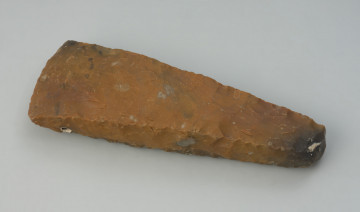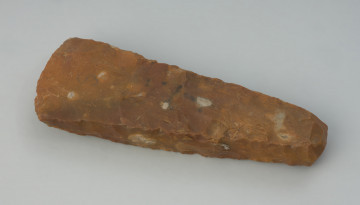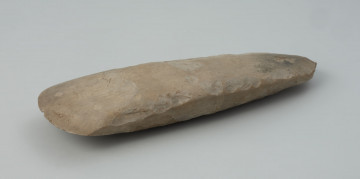
Flint adze
National Museum in Szczecin
Part of the collection: Stone Age
The flint tool found its way to the Szczecin Museum collection in 1910, along with a dozen or so other finds unearthed in the villages of Ognica (German: Nipperwiese), Podjuchy (German: Podejuch) and Zdroje (German: Finkenwalde) during intensive works to regulate the Oder River in the early decades of the 20th century. Archaeological discoveries made while reconstructing the river's course and directing the main estuary channel along its eastern arm were so numerous and valuable that in 1909 the state authorities decided to oblige the department of public works to take care of their fate and transfer them to museum collections. Such artefacts were often found in the baskets of washing machines, where stones and other objects had accumulated. Their location was recorded, and if possible, information about the context in which they were deposited. Such data was collected for several artefacts dredged from the East Oder (Regalica) in the first decade of the 20th century near Szczecin Podjuchy, at the 735th kilometre of the river. It was also noted that remains of an oak pile construction were encountered nearby, probably related to a river crossing in prehistory. The flint tool was originally described as an axe with a destroyed blade. Later, attention was drawn to the shape of wider surfaces of the object in the vicinity of the destroyed blade. One is slightly concave and the other convex, suggesting that the blade was curved in shape when seen from the front. Such a technical detail distinguishes tools of the punch type used for cutting wood along its fibres. With them, it was easier to carve concave surfaces, e.g. of troughs or one-foot boats. The tetrahedral, trapezoidal form with a narrow and blunt shank connects the tool with the Neolithic Funnel Beaker culture.
Krzysztof Kowalski
Author / creator
Dimensions
cały obiekt: height: 16.8 cm, width: 4.9 cm
Object type
adze
Technique
hand made, smoothing, carving
Material
flint, stone
Origin / acquisition method
acquisition
Creation / finding place
Owner
National Museum in Szczecin
Identification number
Location / status

National Museum in Szczecin

National Museum in Szczecin

National Museum in Szczecin
DISCOVER this TOPIC
Museum of King Jan III's Palace at Wilanów
DISCOVER this PATH
Educational path